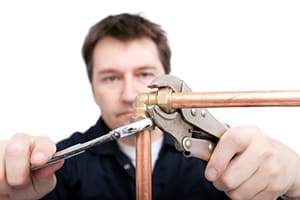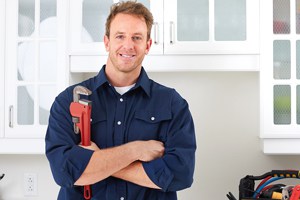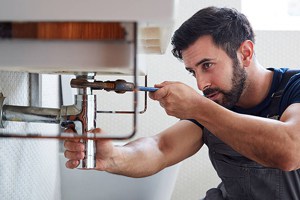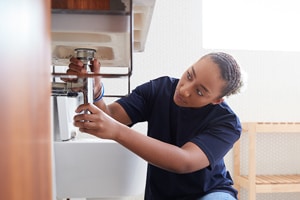Plumbing School Information
Attending a plumbing school can set you up for a career in one of the most attractive sectors of the skilled trades industry. Trade schools offer streamlined training that is convenient and relatively quick. Plus, vocational training often counts toward the length of your apprenticeship. Plumbers generally benefit from good pay, varied work, and potential for advancement.
Plumber Education & Training
The primary route into this vocation involves an apprenticeship. However, a plumber school program can help people like you gain essential skills that provide a competitive edge when applying for apprentice positions.
Plumbing Schools
Sponsored Listings
Porter and Chester Institute
- Bridgeport, Connecticut
- Hamden, Connecticut
- New London, Connecticut
- Waterbury, Connecticut
- Plumbing
Length of Training
It generally takes between four and 24 months to complete a pre-apprenticeship plumbing program at a vocational school. Plumbing apprenticeships typically last for four or five years in total. In some cases, credits earned from previous trade school programs can be applied toward an apprenticeship, which shortens it.
Program Options
You can take a plumbing program at a trade school or vocational college, complete an apprenticeship, or pursue a combination of those two options.
To pursue a career in plumbing, you have several pathways to choose from:
- Enrolling in a program at a trade school or vocational college
- Completing an apprenticeship
- Opting for a combination of both education and apprenticeship
The choice of your training pathway will influence several critical aspects of your training:
- How long it will take to achieve your plumbing certification
- The requirements for admission into a plumbing training program
- The overall cost to complete your plumbing training
Certificate or diploma programs: These typically take no more than a year to complete. They are designed to help students learn basic plumbing concepts and skills.
Associate degree programs: These can last up to two years. They tend to include the same kinds of courses as certificate or diploma programs and also incorporate more general education courses like math and science.
Plumbing apprenticeship programs: Most plumbers learn the trade this way, typically taking four or five years. Some go straight into a program while others complete a certificate, diploma, or degree first. Apprentices undergo classroom lessons as well as on-the-job training, for which they receive a wage.
Most apprenticeships are managed by unions or other industry associations, such as:
You can also search for registered apprenticeships through the U.S. Department of Labor.
Typical Courses
Plumbing schools tend to provide training in areas like:
- Blueprint reading
- Pipe system design
- Water supply systems
- Gas piping systems
- Drainage systems
- Installing and repairing pipes, fittings, and valves
- Brazing and soldering techniques
- Backflow principles
- Plumbing codes
- Safety protocols
Skills You Can Learn at a Plumber School
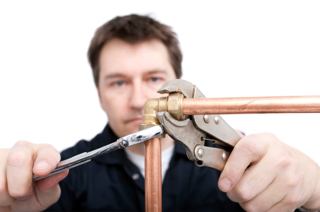 At a plumbing trade school, you could begin learning how to:
At a plumbing trade school, you could begin learning how to:
- Interpret blueprints
- Calculate plumbing measurements
- Design and install piping systems in different settings
- Install, troubleshoot, and service various plumbing fixtures and appliances
- Use tools like plungers, pliers, pipe wrenches, and soldering torches
- Perform work according to relevant codes
- Follow established safety practices
- Estimate plumbing jobs
Licensing & Certification
In most states, you must obtain a license before you can officially work as a professional plumber or, in some instances, even before you can formally start an apprenticeship. In some cases, licensing is done at the city or county level. So it's important to find out what regulations apply in your area.
There tend to be different licenses, such as apprentice/trainee, journeyman, and master.
Licensing requirements vary by locality and level. However, you will typically have to:
- Be 18 years of age or older
- Have a high school diploma or equivalent
- Have a clean criminal record (no felony convictions)
- Apply and pay a fee
- Pass an exam
Some states require special licenses or certifications, depending on the type of work you hope to perform. For instance, you may need to get a medical gas piping license or endorsement to work on the systems that carry gases like oxygen and nitrous oxide in healthcare facilities. And many states have special requirements for plumbers who work with propane or natural gas systems.
Use CareerOneStop's license finder to check the requirements in your state.
Education & Training FAQs
Do plumbers need to know a lot of math?
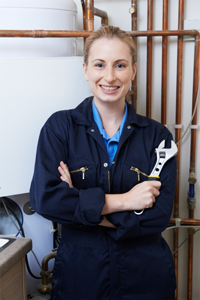 Plumbers typically deal with basic addition, subtraction, multiplication, and division. They must also be comfortable converting decimals to fractions.
Plumbers typically deal with basic addition, subtraction, multiplication, and division. They must also be comfortable converting decimals to fractions.
They may need to calculate things like the volume of a water tank, the water pressure at different depths, or larger pipes' capacity versus smaller pipes. But in most cases, that means plugging numbers into a formula. Once you do that a few times, it becomes relatively automatic.
If I become a licensed plumber in one state, will my credentials be recognized in another state?
Some states have reciprocity agreements that allow licensed plumbers from certain other jurisdictions to practice the trade in that area without obtaining a new license. You can check for such agreements through the National Center for Construction Education & Research.
Is plumbing hard to learn?
Plumbing can be straightforward to learn if you focus on keeping up with your coursework and have decent memorization skills. It's important to remember, though, that much of the trade is learned and practiced during your apprenticeship. Plumber trade school provides the groundwork of knowledge to help you succeed as an apprentice (plus your program credits may count toward your apprenticeship). And an apprenticeship provides the skills needed to succeed as a journeyman and, eventually, a master plumber.
Career Information
Plumbing is a rapidly growing trade that offers the potential for high wages, stable work, and multiple avenues for advancement or specialization.
Plumber Salary
The median annual wage for plumbers, pipefitters, and steamfitters is $61,550,* according to the Occupational Outlook Handbook (OOH). The highest earners make $103,140 or more.
Job Openings & Outlook
Bureau of Labor Statistics (BLS) projections show that the employment of plumbers, pipefitters, and steamfitters is expected to grow by 6 percent from 2023 to 2033.*
Over that same period, an average of 43,300 jobs should become available each year.*
Key Benefits
- Steady work: Since plumbing is often carried out indoors, it's a year-round occupation with less chance of downtime caused by seasonal changes.
- Consistent demand: Water supply systems are crucial to our daily lives. That means plumbers are essential workers whose expertise is continually needed.
- Advancement potential: You can progress all the way to master plumber and become a self-employed contractor. Or you could pursue roles like plumbing supervisor, job estimator, inspector, and more.
What a Plumber Does
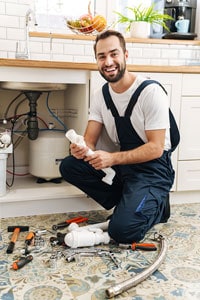 Plumbers make it possible for water, gases, wastes, and liquids to be carried throughout all types of buildings, from homes and offices to factories and hospitals.
Plumbers make it possible for water, gases, wastes, and liquids to be carried throughout all types of buildings, from homes and offices to factories and hospitals.
Common responsibilities include:
- Planning the installation of plumbing systems following safety standards, building codes, budgets, and timelines
- Ensuring that plumbing system plans work with the intended location of other necessities such as electrical panels and wires
- Preparing materials for installation by measuring, bending, cutting, and threading pipes
-
Preparing buildings for the installation of pipes and plumbing systems, including:
- Cutting holes in floors, ceilings, or walls
- Installing ceiling joists and hanging steel supports for pipes
-
Installing, testing, maintaining, and repairing items like:
- Sinks
- Faucets
- Toilets
- Bathtubs
- Showerheads
- Water heaters
- Washing machines
- Dishwashers
- Garbage disposals
- Handling emergency issues like pipes that have burst or septic systems that have backed up
- Following safety guidelines and building codes
- Inspecting completed work to ensure that it's up to code
- Providing estimates for repairs
- Supervising and mentoring laborers, apprentices, and new journeymen
Work Settings
Plumbers work in any setting that needs running water. For example, that can include places like:
- Homes
- Offices
- Schools
- Restaurants
- Stores and shopping malls
- Entertainment venues
- Factories
- Hospitals
- Airports
- Government buildings
- Hotels
- Cruise ships
- Industrial plants
- Construction sites
According to the Occupational Outlook Handbook, most plumbers, pipefitters, and steamfitters work for plumbing or heating and cooling contractors. About six percent are self-employed.*
Specializations
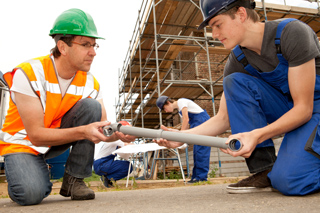 People who go into the pipe trades can choose to specialize in several areas, some of which require additional training or other qualifications. Examples include:
People who go into the pipe trades can choose to specialize in several areas, some of which require additional training or other qualifications. Examples include:
Residential plumbing: Focus on installing and repairing pipes, fixtures, and appliances in houses, condos, and other private residences.
Commercial plumbing: Work on piping systems and appliances in large settings like office buildings, retail stores, hospitals, and schools.
Gas fitting: Install and repair natural gas piping and related appliances, such as stoves, fireplaces, water heaters, and hot tubs.
Medical gas piping: Concentrate on the systems that deliver gases like nitrous oxide and oxygen to medical patients.
Pipefitting or steamfitting: Fabricate, assemble, install, and service piping systems in commercial and industrial settings. You could deal with systems for carrying anything from chemicals for manufacturing to high-pressure steam for generating electricity.
Sprinkler fitting: Perform the installation, repair, and maintenance of fire sprinkler systems in all types of buildings.
Plumbing inspection: Check completed plumbing work to ensure that it was done correctly and following applicable codes.
Get Started Learning to Become a Plumber
Training at a plumbing school offers a clear path to entering a trade that's both reliable and varied. The focus of vocational training is to prepare students for the workforce, with only the courses necessary for learning the trade. The sooner you find a school near you, the closer you are to becoming a plumber. Find one today!
* Bureau of Labor Statistics, U.S. Department of Labor, Occupational Outlook Handbook. Some careers listed may be part of a combined occupation profile (visited October 22, 2024).




